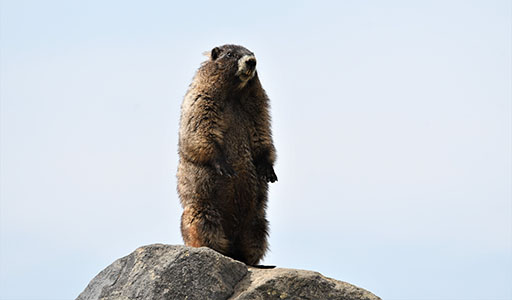Marmots

Marmot Information
Marmots are large rodents with large claws and brown fur the size that grow to about the size of a housecat. Marmots are known for their ability to dig long tunnels and burrows beneath the earth. When they dig these burrows, marmots can damage your lawn, garden, and even your home. From September to May typically, marmots hibernate underneath the ground. When they are not hibernating, marmots can carry diseases that can affect both pets and humans.

What does a Marmot look like?
Marmots can grow up to 2 feet in length and weigh nearly 12 pounds. Males are larger than females, though both genders have sturdy bodies and short, wide heads. Their coats are varying shades of brown with noticeable patches of yellowish fur on the sides of their necks. In rare instances, marmots appear dark brown or even black. They have short legs, small ears, front claws for digging, and furry tails. The rodents resemble overgrown squirrels.

What does a Marmot eat?
Herbivorous, marmots subsist off diets of grasses and other vegetation. Some of their favorite foods include berries and other fruits, lichens, mosses, vegetables, flowers, and roots.

Marmot habitats
Found in forested areas, arid plains, and mountain ranges, marmots are adaptable and survive in a number of climates. They create burrows in which they raise their young, hide from predators, and hibernate. These nests have many tunnels branching off the main passageways and often connect to other burrows in the surrounding area. Unlike prairie dogs and groundhogs, marmots can inhabit areas of high elevation and will burrow into rocky outcrops, which allows them to better observe their surroundings.
Identifying Marmot Droppings
Like many rodents, marmots leave droppings that are small, dark in color, elongated, and pointed on the ends. However, unlike similar animals, marmots rarely leave their feces in yards. Instead, they build latrine chambers in their burrows. Pests like squirrels, skunks, and prairie dogs tend to be the culprit in mistaken feces identification. If homeowners have indeed found marmot droppings, they will usually be located within a couple feet of a burrow entrance as the rodents use a mixture of earth and feces to seal the entrance before hibernation.
Using Tracks to Identify Marmots
Weighing over ten pounds and measuring two feet in length, these pests leave deep and well-defined footprints. Marmot tracks can wreak havoc in damp areas of the lawn or near walkways where tidy appearances are important. Since the animals are active from early March throughout September, they’re usually outdoors during the tail end of winter. Marmot tracks in the snow are often accompanied by drag marks left from the animals’ bellies brushing the ground. When prints are found, it may indicate the presence of multiple marmots, as the pests can live in colonies of up to 20 individuals.


